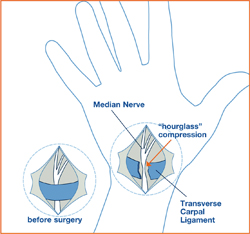 A condition that involves a pinched nerve in the wrist
A condition that involves a pinched nerve in the wrist
What is it?
Carpal Tunnel Syndrom (CTS) is a condition that involves a pinched nerve in the wrist. The Carpal Tunnel is a place in the wrist where nine tendons go from the hand to the forearm. When pressure builds up in this area, it puts added stress on the nerve, which can cause pain, tingling and numbness in the hand and fingers.
What causes it?
There’s no one one cause, but rather several associated activities and conditions. The pressure on the nerve can happen as a result of bending the wrist for extended periods of time. Also, water retention brought on by pregnancy can cause swelling in the tunnel, which generally goes away after delivery. Other medical conditions, such as diabetes, thyroid conditions and arthritis can also be associated with CTS.
 What are the symptoms?
What are the symptoms?
Signs that you may have CTS include pain, tingling, or numbness, or some combination of all three. Numbness is most often felt in the thumb, ring, index and middle fingers. Sufferers of the condition may be affected by symptoms during the night or during daily activities, like driving or handling a newspaper. You could notice a weaker grip which might cause you to drop things.
How do we diagnose it?
It’s necessary to get a detailed medical history, including past injuries and daily activities. We may take an x-ray to look into causes like arthritis or fractures. Lab tests may be done if we suspect a separate condition that is associated with CTS. We may use Electrodiagnostic studies (NCV–nerve conduction velocities and EMG–electromyogram) in order to confirm the diagnosis and check for other nerve problems.
How is it treated?
 Surgery is not always necessary to relieve symptoms. Treatment may be as simple as changing habits of hand use, or reducing pressure on the nerve by using a wrist splint. Injecting steroids into the carpal tunnel can reduce swelling and relieve symptoms as well. Surgery may be required if these non-surgical methods don’t improve symptoms. Nerve pressure is significantly decreased by cutting the ligament that makes up the top of the tunnel on the palm side of the hand. The goal of any CTS surgery is to widen the tunnel and lower the nerve pressure. After surgery, soreness is common for several weeks or months. Symptoms of the condition may disappear quickly in some cases, but could take longer. Restoration of normal hand strength and wrist may take several months. Although surgery improves conditions for almost all patients, CTS symptoms might not completely go away in more extreme cases.
Surgery is not always necessary to relieve symptoms. Treatment may be as simple as changing habits of hand use, or reducing pressure on the nerve by using a wrist splint. Injecting steroids into the carpal tunnel can reduce swelling and relieve symptoms as well. Surgery may be required if these non-surgical methods don’t improve symptoms. Nerve pressure is significantly decreased by cutting the ligament that makes up the top of the tunnel on the palm side of the hand. The goal of any CTS surgery is to widen the tunnel and lower the nerve pressure. After surgery, soreness is common for several weeks or months. Symptoms of the condition may disappear quickly in some cases, but could take longer. Restoration of normal hand strength and wrist may take several months. Although surgery improves conditions for almost all patients, CTS symptoms might not completely go away in more extreme cases.


